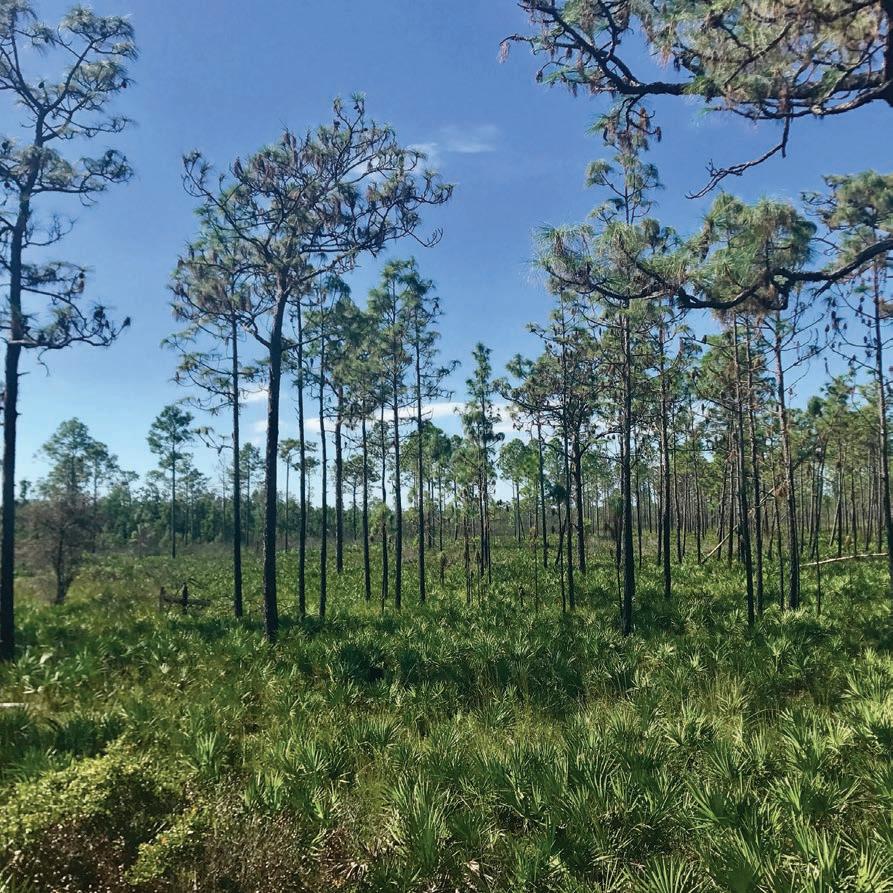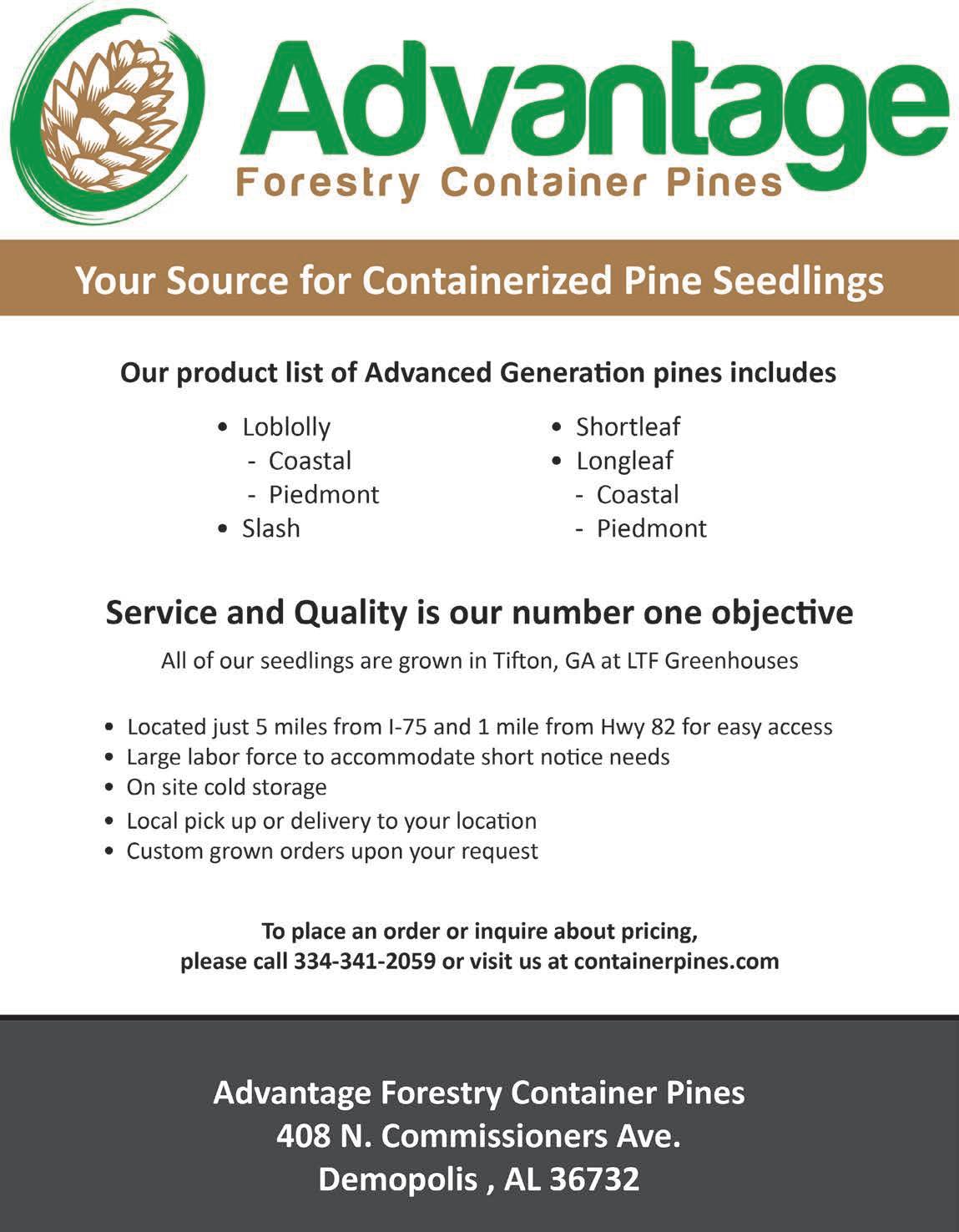
7 minute read
Longleaf Destinations
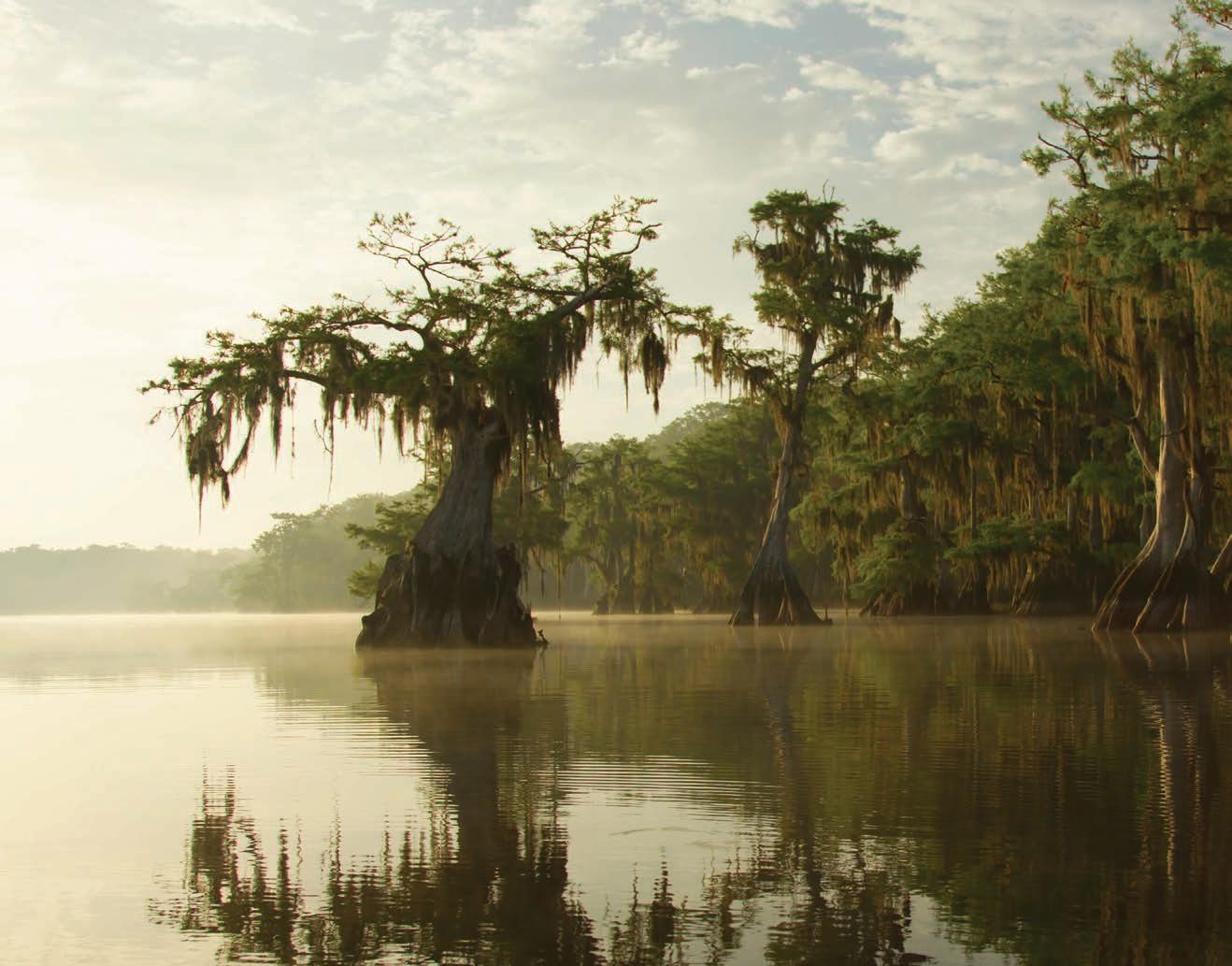
Longleaf By Kirsten Weir and The Nature Conservancy Staff Destinations
Advertisement

Longleaf Pine Thrives at The Nature Conservancy’s Disney Wilderness Preserve
If you imagine a time before the theme parks of the Orlando area, you conjure images of the incredible natural landscapes and iconic wildlife of Old Florida, with its expansive longleaf pine forests and vast, essential wetlands. Bring yourself back to the present, and you’ll find a place like this thrives today— The Nature Conservancy’s (TNC) Disney Wilderness Preserve. The 11,500-acre property, located near Kissimmee, is owned, protected, and managed by The Nature Conservancy. In 1992, following a recommendation from Audubon Florida to protect the initial 8,500-acre ranchland from proposed construction of housing subdivisions, TNC worked with the Walt Disney Company and the state of Florida to create a large-scale nature preserve to offset wetland impacts of the development at Walt Disney World. And so, Disney Wilderness Preserve was born, restoring historic wetlands across a large landscape, and creating a haven for more than 1,000 species of plants and animals. Today, the Preserve serves as a testament to how bigpicture thinking can create more resilient landscapes.
The original cattle ranch had been in operation since the 1940s. Its natural wetlands had been significantly degraded by decades of grazing and creating drainage ditches that altered the water’s natural flow. The Walt Disney Company provided funding for restoration and monitoring, and in 1995, the greater Orlando Aviation Authority added an adjacent 3,000 acres to mitigate its airport expansion.
In the years that followed, TNC restored 3,500 acres of wetlands, returning the landscape to its natural state. Nearly half of the Disney Wilderness Preserve is made up of longleaf pine
A.
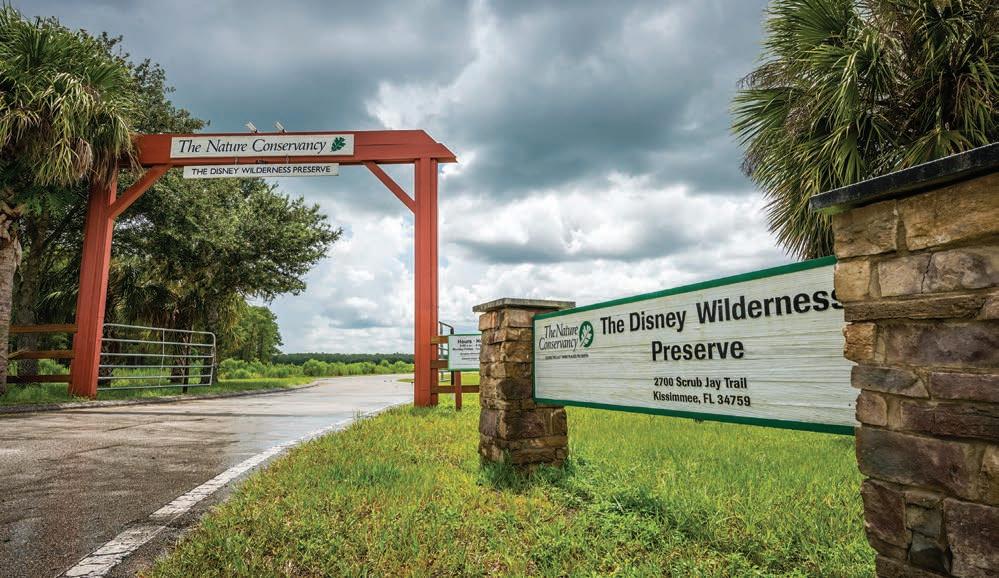
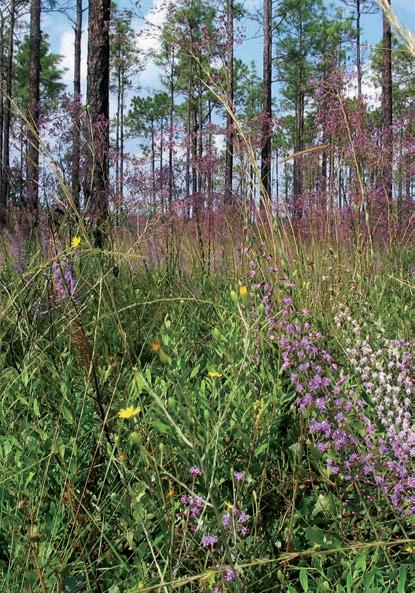
C.
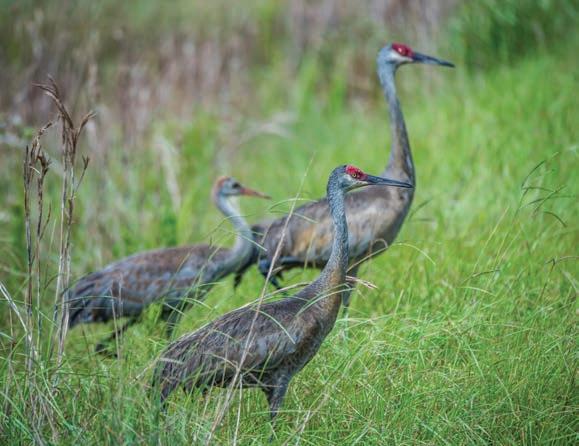
A. Entrance to the Disney Wilderness Preserve. Photo by Roberto Gonzales. B. Wildflowers at DWP. Photo by Zachary Prusak. C. Sandhill Cranes at DWP. Photo by Roberto Gonzales.
B.
flatwoods, with cypress and hardwood swamps, freshwater marsh, oak hammocks, and scrub rounding out the classic Old Florida landscape. Repairing these ecosystems required years of hands-on work such as filling in ditches to restore the natural water flow, removing invasive species, converting pastures back to native groundcover, and beginning a program of prescribed burns to restore the health and diversity of the longleaf forest.
The Walt Disney Company transferred ownership of the Preserve to TNC in 2012 – once the mitigation project was successfully completed – and provided an endowment for the property’s continued management.
The species-rich longleaf pine ecosystem was once a dominant habitat in Florida, originally occurring in about 50% of the state. Development throughout Florida reduced this drastically, and suppressing the natural fire cycle led to a reduction in the number of plants and animals that depend upon this natural process to thrive. The presence of such a large amount of longleaf pine on the Preserve offered TNC an opportunity to utilize fire management techniques to restore and showcase what Central Florida’s landscape looked like centuries ago.
The Nature Conservancy’s staff began implementing small burns since the landscape hadn’t seen fire in quite some time, causing the mid-story vegetation to increase. Freed by the flames, the property’s remaining longleaf habitat was able to recover and expand, and grasses and other groundcover to rebound. With the cycle of fire restored, managers adopted a high-frequency/low-intensity regime, with annual burns across
about a third of the Preserve. These regular prescribed burns continue to be possible, in part, because of conservation partnerships with other landowners in the region, who support and learn from one another’s efforts. Thanks to these joint efforts, Disney Wilderness Preserve is part of a large mosaic of natural landscapes across Central Florida that includes longleaf pine and other essential habitats.
Just as fire is critical to this ecosystem, water is equally essential. As ditches were filled in, the wetlands rebounded quickly to fill their historic footprints and fulfill their broader role. The Preserve sits at the headwaters of the Everglades. Its wetlands soak up rainwater, filter nutrients, and help replenish groundwater as it seeps slowly back into the soil.
The highlight of this system is peaceful Lake Russell. Surrounded by towering cypress, it is the most-visited spot. Unlike most Florida lakes, Lake Russell is devoid of human development, with no homes dotting the shoreline. When Hurricane Irma passed through in 2017, the lake absorbed the extra rainfall, swelling its bank to extend 60 or 70 feet past its typical lake edge. Over the next two weeks, it released that water slowly back into the streams—a textbook example of a lake functioning the way nature designed. Visitors hiking the Red Wilderness Trail to Lake Russell often hear the hoots of the barred owl and might spot wood storks—North America’s only native stork— roosting in a large rookery in trees along the shore.
Hiking deeper into the Preserve, visitors might see other feathered residents, including Bachman's Sparrow, the iconic Florida scrub-jay, and the recently reintroduced red-cockaded woodpecker. Listed as endangered in 1970, the woodpeckers hovered on the brink of extinction until conservation efforts helped re-establish breeding pairs in their historic range. In 2007, following the successful restoration of the longleaf forest, the Preserve was invited by the U.S. Fish and Wildlife Service to join the red-cockaded woodpecker translocation program. Ten pairs of woodpeckers now reside at Disney Wilderness Preserve—a sizeable population for birds that require large territories to thrive. Birdwatchers looking skyward might catch sight of a tower nestled in the landscape, which collects environmental data as part of the National Ecological Observatory Network. It’s a symbol of the Preserve’s commitment to advancing conservation knowledge. Now that the property has been restored, managers are stepping up efforts to find new ways to learn and connect. More than a dozen environmental research projects are active inside the Preserve. The landscape serves as a model for how state-of-the-art conservation management can create healthy, resilient landscapes where both people and wildlife can thrive. TNC has plans to increase its commitment to advancing conservation knowledge and action through education, outreach, science, and stewardship at Disney Wilderness Preserve.
An all-female crew conducted a controlled burn at DWP in March 2019 to inspire more women in fire work. Photo by Carlton Ward Jr.
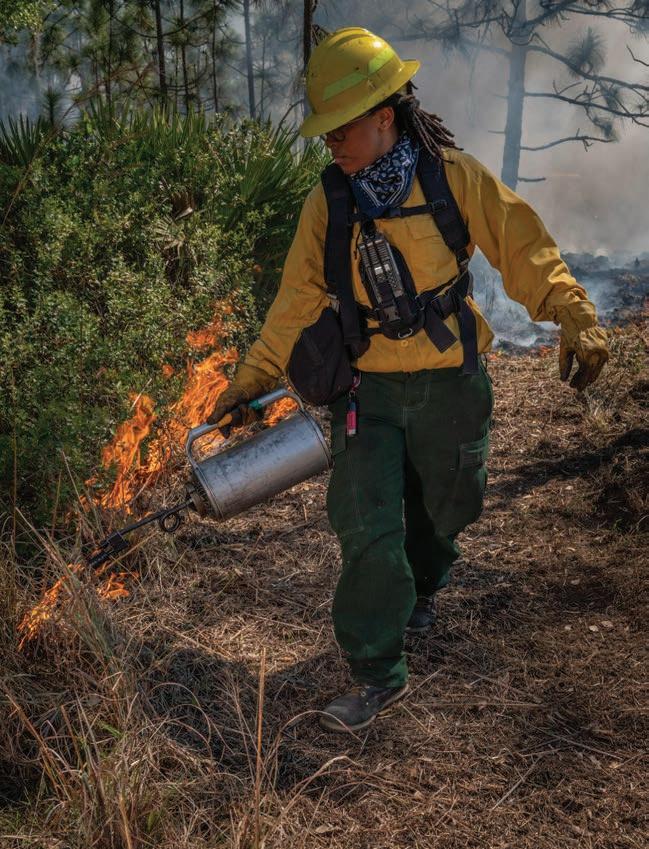
Visitor Tips
The Disney Wilderness Preserve is located at 2700 Scrub Jay Trail in Kissimmee, less than an hour from the bustle of Orlando, and is a welcome respite from the area’s theme parks for those seeking more natural pursuits. Entrance is free, but donations are welcome. There is parking onsite, and visitors should sign in at the welcome center. Picnic areas and restrooms are available. Pets, smoking, alcohol, and weapons are prohibited.
The Preserve is largely longleaf habitat, so be prepared to hike in open areas with a lot of sun. The best time to visit is October through May, when temperatures are milder and conditions are drier. Late September to early November is peak wildflower season, with iconic species such as blazing star, goldenrod, lopsided Indiangrass, and numerous other beautiful flowers that bloom in areas that have been recently burned. Trails may flood during the summer rainy season, so call ahead to check conditions before you visit. Keep an eye out for sandhill cranes as you drive in.
The flat, open Red Trail forms a 2.5-mile loop with a detour that will take you to the shore of Lake Russell. It connects with the Yellow Trail, an additional 3.6 miles that heads deeper into the Preserve. To hike the Red and Yellow Trails combined, plan on about three hours.
For information, call 407-935-0002 or email visitdwp@tnc.org.

B.

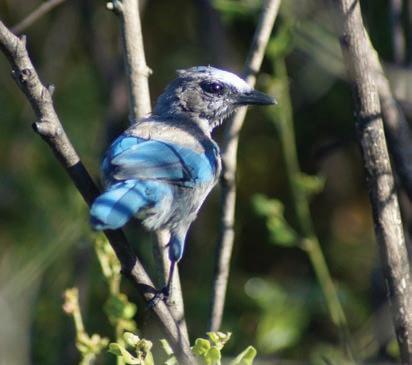
A. Florida scrub jay. Photo by Hannah O'Malley.
B. Group buggy tour at DWP. Photo courtesy of Roberto Gonzales. C. Frequently burned longleaf pine. Photo by Fran Perchick.
C.
